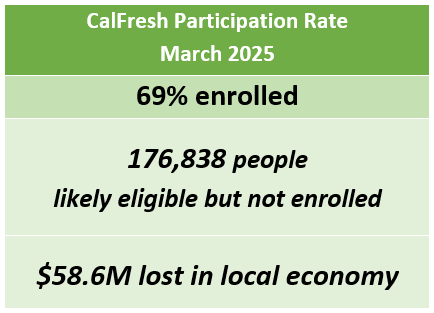State of Hunger in San Diego County
This research was conducted with input and guidance from the Hunger Free San Diego advisory board, a collaboration of agencies facilitated by San Diego Hunger Coalition.
More than 1 in 4 people in San Diego County is nutrition insecure.
San Diego Hunger Coalition estimates that, as of March 2025, more than 1 in 4 (26%) San Diegans experience nutrition insecurity, or are unable to provide three, nutritious meals per day for themselves and/or their families. This marks the first time since 2020 that the nutrition insecurity rate surpassed 26%, meaning hunger has returned to pandemic levels.
Out of the 848,000 total people estimated to be nutrition insecure in San Diego County, 218,000 of them are children, 182,000 are older adults (age 60+), and 137,000 of them are living with disabilities.
Food Assistance: The hunger relief sector provided 30.3 million meals in food assistance in March.
In March 2025, the hunger relief sector in San Diego County provided 30.3M million meals across all programs, meeting 91% of the estimated need for food assistance.
Of the 30.3M meals that were provided in March, 16.7M (55%) meals came from CalFresh, followed by school meals, food banks and pantries, WIC, and meals for older adults. The pie chart below shows the breakdown in more detail.
Meal Gap: Another 3.1M meals would have been needed for a hunger free region
Despite the millions of meals that came from food assistance in March, the county was still short by almost 3.1M meals, meaning thousands of families around the county went hungry during the month, with areas such as University City, Escondido, College Grove, and Fallbrook all having more than 250,000 missing meals each. To see a map of the meal gap and other data points, click here.
The Hunger Coalition has also identified an additional 176,000 people who are likely eligible for CalFresh but not yet enrolled, showing great potential to reduce the meal gap by increasing CalFresh participation.
Recent enrollment data also show that the county is making significant ground on CalFresh enrollment, as there are now 25,000 more people enrolled than there were in September 2023. Enrolling all eligible families is the best way to decrease hunger and mitigate the effects of the loss of the temporary federal programs, as providers struggle to keep up with the increased need. For more information on where likely eligible populations are and for CalFresh participation numbers, please visit www.sdhunger.org/maps-tables.
Nutrition Security and Equity
Nutrition insecurity also disproportionately impacts Black people, Indigenous people, and people of color. The nutrition insecurity rates of these communities are all above the average, as can be seen below.
23% of the Native population
17% of the White population
20% of the Asian population
30% of the Hispanic/Latinx population (across all nationalities)
33% of the Black population
Additional analysis of the nutrition insecure population shows that Hispanic/Latino people make up 33% of the county population, yet they constitute 50% of the nutrition insecure population, which is the largest disparity by race/ethnicity in our region. Data on race/ethnicity is annual, currently estimating San Diego County in 2023.
Methodology
These estimates come from SDHC’s analysis of the estimated population at risk of nutrition insecurity. We define this population as households with incomes below 225% of the Federal Poverty Level (FPL) ($72,000 for a family of 4). For the meal gap calculations, we track food assistance data gathered from local agencies and nonprofit partners, with ongoing recommendations from the Hunger Free San Diego Advisory Board. Our detailed methodology can be found at the top of this page.







